|
[Home]
[Up]
| |
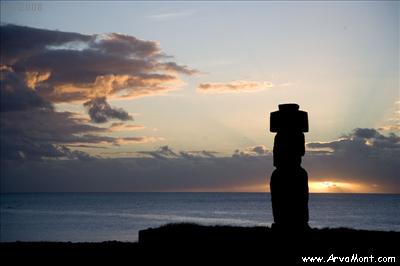 We have arrived in Rapa Nui, the
easternmost island settled by the Polynesians, also known as Easter Island, or
Isla de Pascua in Spanish. This island is a part of Chile, although it is
in the middle of the Pacific Ocean, equidistant from Tahiti and Santiago, and is
really more oceanic than South American. Rapa Nui is not actually close to anything - it took us 5 hours to fly
here and it is another 4.5 hours to Santiago! Furthermore, it is not a beautiful, warm island surrounded by coral
and tropical fish, like the Polynesian islands we left. Rapa Nui is a
craggy, rock covered, grassy island with a temperate climate, covered with moai. We have arrived in Rapa Nui, the
easternmost island settled by the Polynesians, also known as Easter Island, or
Isla de Pascua in Spanish. This island is a part of Chile, although it is
in the middle of the Pacific Ocean, equidistant from Tahiti and Santiago, and is
really more oceanic than South American. Rapa Nui is not actually close to anything - it took us 5 hours to fly
here and it is another 4.5 hours to Santiago! Furthermore, it is not a beautiful, warm island surrounded by coral
and tropical fish, like the Polynesian islands we left. Rapa Nui is a
craggy, rock covered, grassy island with a temperate climate, covered with moai.
What is a moai?
(It is pronounced "mo eye".) It is a figure carved of rock and generally
greater than life size. Many Moai were moved as much as 15 miles and set
upright on ahu, which are ceremonial stages or pedestals, all over the island.
The most accurate thing that can be said about moai is that no one really knows
too much about how or why they were
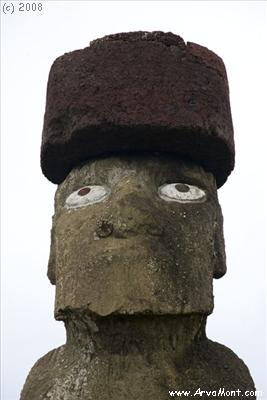 made
or transported. Interestingly, when the first Europeans arrived in the
1700s, many of
the Moai were still standing on their ahu, but by 1868, they had all been
toppled. It was clear that many were purposely knocked over, but not clear
why. made
or transported. Interestingly, when the first Europeans arrived in the
1700s, many of
the Moai were still standing on their ahu, but by 1868, they had all been
toppled. It was clear that many were purposely knocked over, but not clear
why.
^ Mouse over for a blink
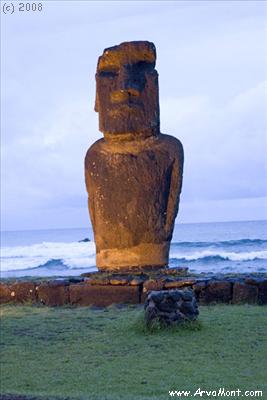
It is thought that
the moai may have been made in the image of important ancestors, and been a part
of a complicated religion of ancestor worship. Again, no one is very sure
on this.

Another big issue here is whether moai should have been left alone, or
whether it was right for earlier archeologists to have rebuilt whole ahu.
This is an issue at many ancient sites around the world. On Rapa Nui half of the major
sites have been left in ruins, while half have been rebuilt. I think that
a full appreciation of the ancient sites could not possibly be achieved if all
of the sites had simply been left in ruins, and that this is a nice compromise.
For more information on Easter Island, a good reference that
we have used is "The Complete Guide to EASTER ISLAND" by Shawn McLaughlin.
The book is published by the Easter Island Foundation (islandheritage.org)
Rano Raraku
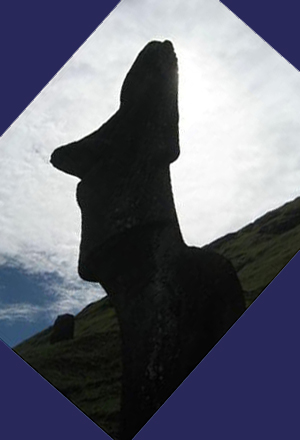
All the moai were
carved at Rano Raraku (the remnants of a volcano), which is also known as the
"quarry" or the "nursery." From what is to be seen in Ranu Raraku, it appears that moai
were entirely carved here, and once completed, they were moved to their desired
location. This was no small task; these fellows can be upwards of 20 feet
tall. (The tallest one actually cut off the side of the cliff is 35 feet
tall, though there is a bust that is 65 feet tall that was not cut out of the side
of the hill. ) The average height and weight of the moai on the island is 13
feet and 12.5 tons, respectively. The moai left lying around Rano Raraku
were apparently rejects. They were not transported and set up on an ahu.
Some theorize that they fell during transport and were abandoned, though no one
really knows. Many have been buried on the side of the hill.


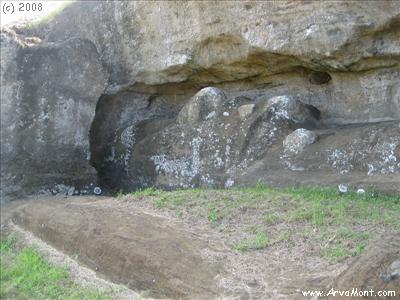


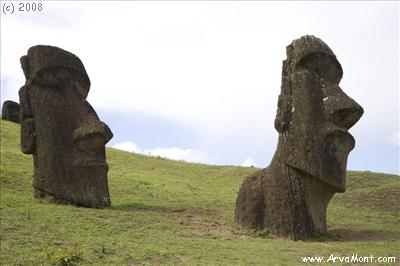
Tongariki
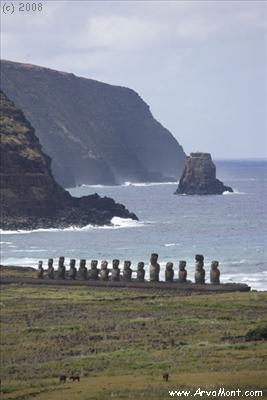
 This
was my favorite ceremonial place. There are 15 moai on the Tongariki ahu,
all of different shapes and sizes, and they stand with such dignity along the
shore. This ahu was rebuilt and then knocked down by a great tsunami of
1960. Then it was rebuilt in the 90's. This
was my favorite ceremonial place. There are 15 moai on the Tongariki ahu,
all of different shapes and sizes, and they stand with such dignity along the
shore. This ahu was rebuilt and then knocked down by a great tsunami of
1960. Then it was rebuilt in the 90's.
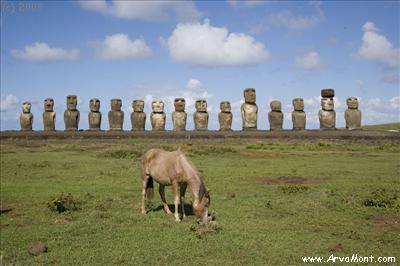
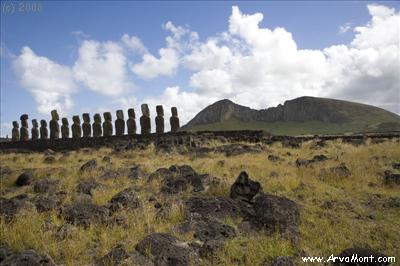
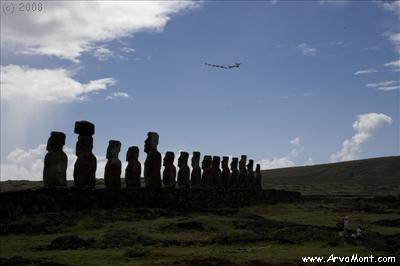
Tasha flying our Chinese kite

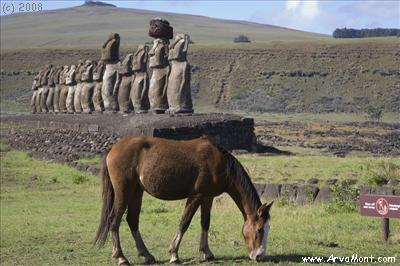
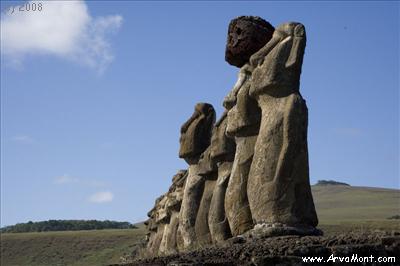
There are wild horses all over the island.
Papa Vaka
This is a famous petroglyph site.
While we can see that all the rocks around here had been carved, it was hard to
discern what the carvings represented. The signage spoke of canoes.



Anakena

While the entire island is a craggy,
rocky mass, at the far north end of the island is a gorgeous beach! It
seemed so out of place! Furthermore, there are so few trees on the island,
and here all of a sudden were a bunch of coconut palms.
{For those of you who have
followed the news (we had not), this is the ahu containing the moai whose ear
was mutilated by a young European in March 2008.}
Rano Kau
There are the remains of two
volcanoes on the island: Rano Raraku (the "nursery"), and this one, Rano
Kau.
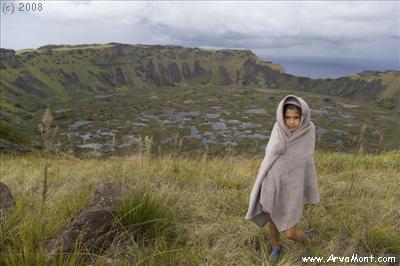

 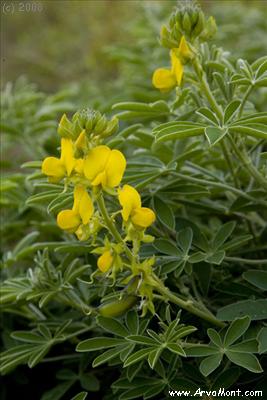

Orongo
This is one of the most sacred sites;
the site of the birdman competition. The chief of each different clan
appointed someone to compete on his behalf, or he competed himself, in this
competition, to determine who would be the ruler of the island for the next
year. The competition took place in the spring, and its objective was to
be the first competitor to return to the main island with the egg of a sooty
tern. The terns nested on Motu Nui, the furthest, and largest of the
islands below. The competition began at the top of this cliff next to Ranu
Kau, and involved competitors swimming across to the motu through shark-infested
waters, camping on the island until an egg could be found, swimming back and
climbing back up the cliff. How did this qualify you to rule? I
don't know, but there are probably some that feel it is no worse than the US
system at the moment :-)

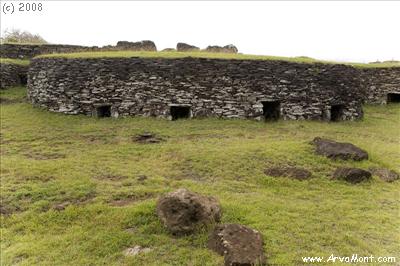

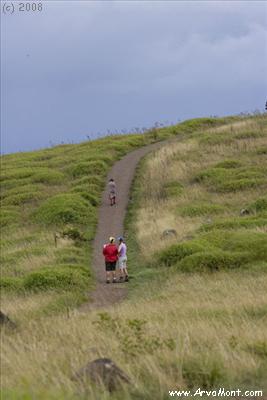
Ahu Akivi
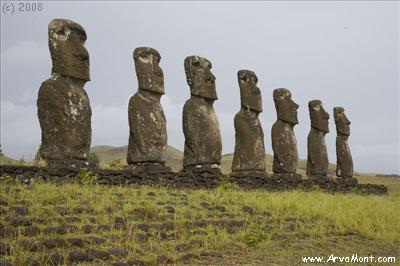
Ana te Pahu

There are many caves on the island.
This one is referred to as a lava tube. It is very long, but it lies just
below the surface, and parallel to it. In fact, you would never guess
there was a cave here, unless you were walking along and encountered a deep
hole!
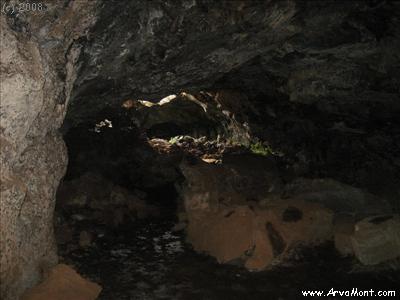

Hanga Roa
This is the only town on the
island. We stayed at a nice, quaint B&B style hotel just off the main
street.
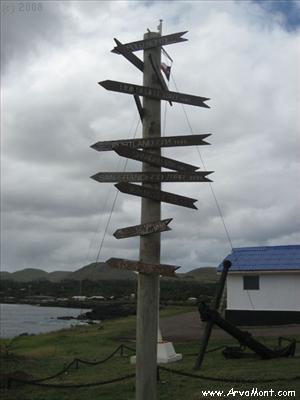 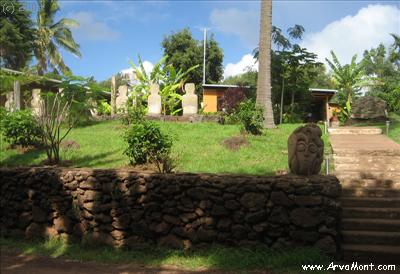
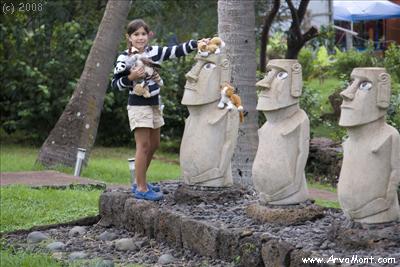

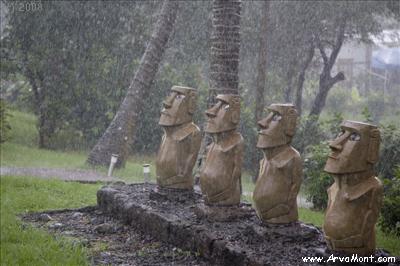
World schooling on the porch.
We received some heavy rains during 4 of our 5 days here.

From Rapa Nui we headed for Santiago on mainland Chile.
|
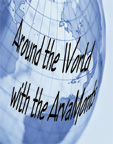 Around
the World With the ArvaMonts
Around
the World With the ArvaMonts







































